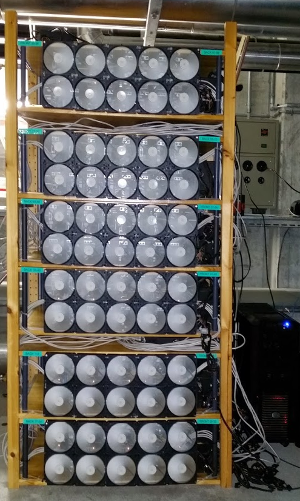Quantum Wolf Cluster
 Laboratory for Quantum Magnetism perform fundamental research combining state-of-the-art experiments with new theoretical developments. For several promising new theories and for ray-tracing simulations of a novel scientific instrument concept, there is a need for increased computational power. Due to easy parallelisation of the computational tasks, we chose to build a custom cluster from consumer hardware. This Quantum-Wolf cluster will provide 5 times more GFLOPS/CHF and consume less W/GFLOPS than a conventional fast-interconnected Xeon-based cluster.
Laboratory for Quantum Magnetism perform fundamental research combining state-of-the-art experiments with new theoretical developments. For several promising new theories and for ray-tracing simulations of a novel scientific instrument concept, there is a need for increased computational power. Due to easy parallelisation of the computational tasks, we chose to build a custom cluster from consumer hardware. This Quantum-Wolf cluster will provide 5 times more GFLOPS/CHF and consume less W/GFLOPS than a conventional fast-interconnected Xeon-based cluster.
Key figures:
96 nodes, 384 CPUs
9.6 TFlops (synthetic, benchmarking will follow)
4.8 kW
312 CHF/ node
Technical description:
96 nodes connected through two switches. The selected hardware:
| Components | Model | Number |
| CPU | Intel i5-3350P | 96 |
| Motherboard | Gigabyte H61M-S1 | 96 |
| Memory | Patriot DDR3 1333MHz 2x4GB | 96 |
| Power supply | FSP AURUM GOLD 600W | 12 |
| Fans | Arctic Cooling F12-PWM | 60 |
| Ethernet cables | Roline Kat. 5e Kabel 1m | 96 |
| Ethernet switch | Zyxel XGS1910-48 | 2 |
Test setup
A test setup with 4 nodes was assembled. Hardware, operating system and actual compute performance was verified and design optimised.
The four motherboards were powered using a single power supply connected through a custom built PCB. The total electricity consumption was 50W per node measured using a power-meter before the bower-board.
Sponsorship:
LQM grateflully acknowledges support from Steg Electronics www.stegcomputer.ch.
Benchmark results:
Benchmarks and records will be posted here
Scientific results:
Project 1: (Jakob Lass, Louring Koch Thorbjørn, Jonas Okkels Birk and Kim Lefmann, University of Copenhagen)
“The simulation is a Monte Carlo simulation of a three dimensional Ising model using the nearest neighbour approximation. Through the principle of universality the simulation is used to study the effect of a limited particle size at and just above the critical temperature. It has been observed through experiments that an antiferro magnetic particle (CoO) has a cut-off in the correlation length as a function of reduced temperature just above the Néel temperature. A plateau is formed with correlation length below full correlation. This behaviour has not been predicted or examined before because the theory used to predict the critical behaviour has been derived using the thermodynamic limit. Here the correlation length is to diverge at the critical temperature. This is however impossible as the particle is limited. The simulation is used to determine if the Ising model shows the same phenomenon as found experimentally.”
 |
 |
 |
Left: Illustration of the simulation; middle: Comparison of the system at a temperature just above “Néel” temperature and at almost zero temperature; right: Correlation length as a function of reduced temperature with double logaritmic axes. (Click to enlarge the figures.)
Web-links:
Links to press-coverage, web-coverage etc will be posted here
Gallery
[epfl:myEpflGalleryBox]